-
Having a family might not come as easily as we had planned.
I have written here before that with each pregnancy I feel a deep sisterly mourning with the others in the room: those waiting for their baby. Statisticians believe that of known pregnancies 20% end in miscarriage and that one in four women will experience one in her lifetime. And there are reasons to believe that the number is actually much higher. I am grateful for this chance to walk beside my friend Susie in her experience, as a reader, through her story.
a note of introduction from Susie (susannawales@gmail.com ): I wrote this essay about infertility and miscarriage nearly four years ago now. I was scrambling for ways to express a grief so often unnamed and to come to terms with my suffering. I sought out many books during those years, some of which were immensely helpful, namely A Grief Observed by C.S. Lewis, Walking with God Through Pain and Suffering by Timothy Keller, and The Hardest Peace by Kara Tippetts (a new documentary about her story was just released). In my experience, the pain of miscarriage doesn’t go away, but it does dull and it does recede. Since that difficult time, I have had the joy of becoming a mother through adoption twice over to two beautiful boys: Victor is now three and Bastion is one-and-a-half years old. I have been astonished at the Lord’s faithfulness to me, and I hope that this description of my journey brings comfort to someone who has likewise suffered.
Content warning: the following beautiful and honest essay contains explicit descriptions of miscarriages. Please evaluate your emotional and mental state before reading, for example whenever pregnant I avoided stories of pregnancy and birth complications.–RR
 by Susie Wales
by Susie WalesAs a newlywed back in 2012, whenever I pictured my life five, ten, or fifteen years down the road, kids were always in the frame. I am the fifth of seven children and my husband Ben is the second of five. We both wanted children and expected to be expecting by our second year of marriage. Then, a couple of months shy of our first anniversary, I miscarried at six weeks. We hadn’t even been trying to conceive but were elated nonetheless that I was pregnant. Then a few days after a blood test confirmed a positive pregnancy and my OB/GYN doctor examined and congratulated me, I miscarried at home. Almost as soon as we had time to cheer, we had lost the baby.
I sat on the toilet and bled, painfully passing bits of tissue. I turned and looked into the toilet for signs of life and scooped up a shiny translucent mass of tissue. I held it in the cupped palm of one hand and gently probed at it with my other index finger, clearing the blood away. My breath quickened. I tore a square of toilet paper from the wall and swaddled the lump of tissue in it. I stood in silence a few moments, the tiny tissue quivering in my shaking hand. Then I lowered it down into the toilet and flushed. “I think I just bled out our baby,” my voice cracked as I shared the news with Ben on the phone. Upstairs under my bed covers, I rocked from side to side and cried.
Three months later, we conceived again and the baby held on for ten weeks before passing in a rush of bright red clots that disappeared down my shower drain. Suddenly, we had bereaved the loss of two children and felt a weight we hadn’t anticipated. Having a family might not come as easily as we had planned.
Though the miscarriages were painful, we were hopeful we would conceive. After all, those pregnancies had come without strategizing, so now that we would pay closer attention, we thought we would get pregnant in no time. But after the fourth month of trying to conceive without positive results, we consulted an endocrinologist. He discovered I have a condition called Factor V Liden, so I may be prone to clotting, which would make any pregnancy more risky. I left those appointments feeling more discouraged than when I had entered. Keep having regular intercourse, he advised, and try using an ovulation predictor kit.
I hoped that each month would be the one. After each conception window passed, I listened for my body to give me signs of life. When my breasts were sensitive and full, I wondered, “Are they getting ready to nurse a baby?” With every twinge of hunger, I hoped. Was the bloating and cramping just my body readying itself for a growing life? I flipped the calendar to the season in which I’d be nearing the end of my pregnancy and pictured fanning myself in the heat of July or bundling up mid-December. I browsed the “Names I like” document I kept on my computer. I thought about driving to the maternity clothing store in a strip mall nearby, just to look. I dreaded using the bathroom and then sighed with relief when there were no drops of blood in the bowl.
Then month after month, the periods came. On one of those first several months, in the early morning darkness, I awoke to cramping, and stepped to the bathroom. My bare feet recoiled when they met the cold tile floor. I eased onto the toilet, my elbows propped on my thighs, and bled. I slipped back under the comforter and buried my face in Ben’s shoulder. He stirred. “Bleeding?” he asked. “It’s…so sad,” I whispered. We repeated this refrain each month as my periods came. And each month, the dreams I had nursed over the previous two weeks dissipated like morning mist.
During my first two years of trying to conceive, it seemed every woman around me was pregnant. At that time, my two closest friends from college were each on their second babies. All five of my sisters in law had just had babies or were expecting. Ben’s friends from college—all younger than me–continued to share their joyful news. Genuinely excited at first, I soon succumbed to self-pity and jealousy.
I felt a dissonance with my body that I hadn’t previously experienced. I have nurtured children most of my life through babysitting, teaching, being an aunt–yet when I wanted to carry my own children, my body seemed to be stopping me. I stood at my bathroom mirror with my hands pressed on either side of the sink and asked my red-eyed reflection, “What is wrong with you?”
During the summer of that second year of trying to conceive, we moved from Virginia to Michigan and started with a new fertility center. After tests ruled out endometriosis, the doctor prescribed timed intercourse and ovulation predictor kits. Back to that familiar recipe: we tried for a few months to no avail. With the new year came a greater sense of urgency and we moved to the next level of treatment. We were introduced to Intrauterine Insemination (IUI). This procedure increases the odds of conception as a doctor places the male’s sperm deep inside the female’s uterus where it will have higher chances of forming an embryo. We were optimistic.
Then after six straight months of failed treatments, we decided to stop and try on our own again. These treatments were getting costly and my heart ached with each disappointment. We took a break from intervention and hoped for a natural conception.
Then six months later, amidst the bustle of Christmas excitement, I realized I was a few days past my monthly period. The next morning I took a pregnancy test and blinked at the two strips on the test: positive. I clapped my hand over my mouth and rushed to call Ben with the news. Could we really be pregnant? I knew I should be cautious, but my giddiness over seeing a positive after years of negatives cast a hopeful spell over my doubts.
For the next month I gave myself shots of blood thinner into the pinched flesh of my stomach each night. The doctor prescribed these Lovenox shots to keep my Factor V Liden blood clotting in check. Each night I ripped open an alcohol swab, rubbed it over my belly, breathed deeply, put in the needle, pressed the plunger down, and pulled the needle out. I had a cold wash cloth ready to apply and gently press over the spot of injection that stung and burned for a minute or so. It took some practice, but after a couple of weeks, I got through the whole routine without stalling. I took five deep breaths and cheered myself on: “Ok, it’s ok, everything’s ok, you can do it.” It usually took between one and five minutes to gather the nerve and then it was over. It may not be easy, but this pregnancy was progressing, hope was growing.
Two days after my eight week ultrasound, I traveled with Ben to Ohio where he was slated to work a trade show for his company, which sells flavors to the food and beverage industry. We drove five hours to our hotel, wheeled suitcases to our room and Ben eased onto the bed while I headed to the bathroom. When I went to flush the toilet, I noticed three little red drops in the bowl. My chest tightened. I flushed and stepped out to tell Ben I was spotting. While passing bits of blood is fairly normal during the first trimester, I knew that for me, it always preceded a miscarriage. We sat together on the bed, wordless.
The next morning I felt optimistic. I used the toilet and it was blood free when I flushed. After dropping Ben off at his convention center, I drove to a library a few miles away. I arrived about twenty minutes before it opened, parked my car, and dialed my fertility doctor. My shoulders immediately relaxed when I heard the warm, reassuring voice on the other end, “Spotting is very common at the point in your pregnancy.” She said not to worry and planned to see me first thing Monday morning to make sure everything was ok. I smiled into my phone, relieved.
In the library, I found an empty table next to large bay windows that cast squares of light onto the carpet. I set up my laptop and opened up an essay for an MFA program for which I was applying. The essay was about infertility and the despair I felt because of it. Even though I had spotted the night before, I decided to replay the doctor’s calm words in my ears “this is very normal.” It had been a few months since I’d opened this particular essay about grief and loss. Newly pregnant, I felt I was looking back at the tear-filled writer with compassion. I wanted to offer her the same reassuring voice I’d just heard on the phone and soothe her fears. Although I knew miscarriages usually occur within the first trimester, I was already beginning to feel that this pregnancy was different, spotting and all. We had tried for so long for this one, I thought, this baby will come. I think it’s a boy.
It was after lunch while I was sitting in the children’s section of the library when a sudden a pain shot through my lower back. I slipped my laptop into my backpack, slung one strap on my shoulder and hurried to a large, one-stall bathroom at the back of the library. I sat down on the toilet and began bleeding profusely. Large clots came fast. I felt myself lift up and detach, floating above in the ceiling watching myself. I didn’t cry, I didn’t even whimper. I pushed my fingers hard against my tailbone as each rush of blood and tissue came. I leaned forward and then sat upright, rocking slowly back and forth, back and forth. I pressed fingertips to my temples and breathed. When there was a break in the bleeding, I pulled toilet paper from the wall, winding it around one hand so that it looked mummified. Then I stood and stuffed the toilet paper between my legs to catch any blood. I reached up to flush the toilet – now piled with clots. I reached my hand up to pull the lever when something made me hesitate. I reached into the toilet bowl, grabbed an in-tact mass of tissue. It glistened and quivered, sliding through my fingers. I gently laid it down on the floor.
I stared at the mass of blood and started to shake. It wasn’t just a lump of crimson tissue. It was my boy’s broken body. I could cradle him in my hands, walk back through the library, out to the withered flower garden by the parking lot, dig up the cold earth and bury him there. I could kneel at his grave and weep. But I couldn’t leave the bathroom with him, not with my body bleeding and my pants around my ankles. What could I do? My phone – where’s my phone? I fumbled through the pockets of my back pack with my one clean hand, grabbed my phone and took a picture of the mass on the floor. You couldn’t tell how big it was so I placed one hand, palm down, on the tile floor next to it. There was no open casket, no eulogy, but at least I had captured physical proof of my baby’s life. Ultrasounds had showed black and white pictures of his tiny frame, but here I held his bleeding body in my own hand. I scooped it up, released it into the toilet, and began to mop up the floor with toilet paper. I kept filling the toilet with bloody toilet paper and flushing and flushing it.
Tears blurred my vision now; they slipped off my chin, into my ears, down my neck. Snot covered my lips. I ran the faucet over my hands until the water ran clear, digging blood from under my fingernails until my finger pads started to prune. My eyes were stinging now. I raised a shoulder to wipe my nose again and again. I tugged my tight jeans back on and with trembling fingers pulled at the zipper on my coat. I stared at the ceiling, at my sobbing reflection in the mirror. I had returned to myself. I pressed the hot sides of my face and took deep breaths. I was going to have to exit the bathroom, wind my way through the library, and drive the ten miles to the convention center and tell Ben what was happening. I was going to need to keep my composure.
I sat in my parked car at the convention center a few minutes, wiping my nose, then made my way to Ben’s booth. I wound around tables with samples of candy, slushy machines whirling blue raspberry splurpies in circles, and self-serve ice cream machines. It smelled like a carnival and it made me want to vomit. I walk slowly up to Ben and breathed the news in his ear. His face fell and his eyes reddened, “I’m so sorry,” he whispered. We stared at each other for a long moment, then my eyes began to burn. I retreated to the hotel bathroom stall and bled – the clots coming in waves. My body was more in shock than in pain, frozen under the spell of a trauma it was enduring for the third time.
Half an hour later, we started the five-hour trip home. We stopped at a rest area when the blood was soaking through everything and wouldn’t stop. I waddled up to the front doors of the little building, one hand wedged between my legs. I eased onto the toilet, my elbows jabbed into my knees, and held my weary head in my hands. I released a few more clots and felt some relief. When I stood up, my head swam. I had felt this before—I was about to faint. I whispered through dry lips, “Ben! Ben, Ben, I need help.” I crawled on my hands and knees out of the stall and around the corner towards the door. I summoned a louder voice now, “Ben! I need help!” I clawed at the swinging door and managed to pull it open enough for Ben to hear me where he was waiting in the lobby outside. I fell to the floor, my head thudded onto the tile.
I was lying on my back in the middle of the lobby. It was late, pitch black outside the rest area. No one else was there. Ben peppered me with questions: “Susie, can you hear me? Susie, where are we? Susie! SUSIE!” He was loud and demanding. I shook my head from side to side, mumbling assents. He carried me to the car, laid me in the passenger seat, reached in the backseat and ripped open a plastic container of gummy bears he had picked up at the trade show. “We’re going to get you to a doctor. Keep eating these. We’ve got to get your blood sugar up,” he said as he started the car. I smacked my lips hungrily, chewing and swallowing one gummy bear after the other, relishing the rush of energy, my lips sticky. “Susie, what are you eating?” Ben asked, making sure I was conscious. “Gummy bears,” I said, and smiled despite myself. They tasted so good.
My head throbbed and I still felt light headed but I was coming back to myself as we headed towards an urgent care center about twenty minutes from the rest area. Ben decided to call his parents to let them know what was happening. I heard a couple of faint rings and then his mom picked up, “Hello?” “Hi Mom,” he said. “I want to let you know we lost our baby.” His face twitched. There was silence on the other end at first and then a sigh and moan of, “I’m sorry.” He explained that I was bleeding a lot and we were on our way to the hospital. There was no need to come, we just wanted to let them know. Hearing Ben talk on the phone was like a flashlight piercing the fog. I had spent the last few hours in a haze of shock and now I was feeling the reality: I had miscarried again. It both pained and comforted me to hear him state it so plainly. And I realized in that moment after he hung up the phone, as he stared ahead with his hands gripping the steering wheel, that it was not only my loss but his too.
We reached the urgent care center and Ben carried me in, my legs bouncing as he jogged inside. Someone brought me a wheelchair and pushed me down the hall to a room. I was fully conscious now, and I was exhausted. A nurse put an IV in my arm to hydrate me. I could feel something cold trickle down my arm, then slowly the headache I had the last couple of hours began to subside.
A nurse rolled my bed down the hall to the OBGYN unit and parked me next to the ultrasound machine. Her job was to make sure all of the tissue had been expelled from my uterus during my miscarriage. She stuck a condom-covered, gel-topped plastic wand inside me. My body flinched under the sudden pressure and then relaxed as much as it could as she rolled the wand around my uterus, probing for scraps of the baby I had lost. It felt like an intrusion into a private place, like a cocoon was being torn open and scavenged. She peered into her computer screen and I turned my head to see the grainy, black void.
I had had two ultrasounds in this pregnancy so far—the first was at six weeks. My younger sister was in town and she went to the appointment with me. A large-screened television monitor on the wall across from me showed a blurry, bean-shaped fetus. After the doctor printed and handed me a glossy ultrasound strip, my sister took a picture of me as I pinched the shiny photos, holding them in front of my chest. Later that night I had held a vase of fresh flowers Ben bought me and he snapped a photo—life was blooming inside of me! The next ultrasound was at eight weeks: everything looked normal, the baby was growing on schedule, and its heart was pulsing with life.
Just hours earlier, I had held not an ultrasound strip but the substance of those pictures, the blood and tissue that would later be my baby. I had taken pictures of this lost baby. Now faced with an empty ultrasound image, these evidences became even more important to me. I wasn’t just imagining him, right? He was alive in there. As I laid in my hospital bed and turned towards the ultrasound monitor, there was no head to toe measurement, no blinking heart, no sign of any life at all. The baby that held such promise in its tiny, webbed fingers had vanished. The nurse glanced down at me, moved her hand from the computer mouse to my wrist, and offered in a weary voice, “I’m so sorry.” A tear slipped down my cheek and seeped into a crease in my neck as she silently wheeled me back to my hospital room.
A doctor with eyes like periwinkle marbles came into my room. His voice was kind: “Well the good news is that you passed everything naturally.” That’s how the medical community talks about natural miscarriage – as passing all of the tissue. This sounds like a win, something to celebrate, like I’ve just passed the test or passed over the finish line. But what seems more fitting is lost. “You’ve lost everything, all of the tissue was lost, someone was irretrievably lost.”
Ben and I arrived home around 2 A.M., heavy with fatigue, and fell into bed. The next morning was a Monday. Ben left for work and I got up and showered, dried my hair, put on makeup: simple tasks that felt brave considering yesterday’s events.
I called my sister and five brothers one by one and summarized in a few seconds the heart breaking result of the last ten weeks. My younger sister burst into tears, wishing she could be with me, telling me she didn’t know what to say. I called my brothers. “I’m really sorry,” one said. “I’m so sorry to hear that,” said another. The conversations were brief—they didn’t know what to say or didn’t want to pry. I was glad I told them. A few weeks later, I got a note in the mail from one of my older brothers. Just three years prior he had endured the unthinkable horror of losing his three-year-old son in a drowning accident. His tiny cursive font read, “There are no words to extinguish the grief and anguish of loss.” His words covered me like a healing salve. I was going to be OK.
-
Pleased as man with men to dwell
Upon revisiting Boston for three days I was intrigued to find we had already fallen out of city habits–how to hustle, how to be on time, how to evaluate the speed in which a three year old can scooter across town, how to weigh the pros and cons of a quick dinner down the street. The muscle memory of city life had faded.
The initial reason for the trip was to accompany Joe as he had several consecutive days of work and his company’s holiday party which we always like to be at.
I had announced to the girls that all of the expensive glitzy city traditions we’d once maintained were off this year: the Nutcracker tickets, the restaurant-run gingerbread house afternoon, the fancy hotel teas, and city Santas. It was time for new homemade traditions with new Vermont friends! Wasn’t it?
The seven-year-old looked at me like I had pulled the floor out from under her and asked if we could do a few of them “just one more year.” I realized how reasonable that sounded. And I wondered too what I could possibly have been thinking, having carefully woven a rug of traditions for her and set her upon it year after year; then grandly announcing they were all passé as if I were some Oprah magazine cover for January: new year, new YOU.

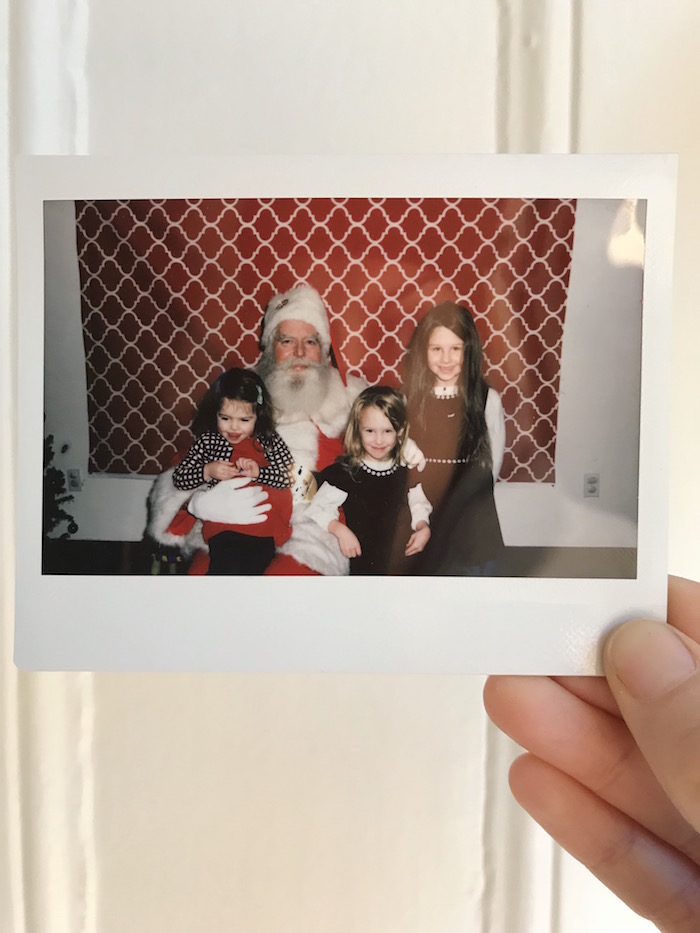


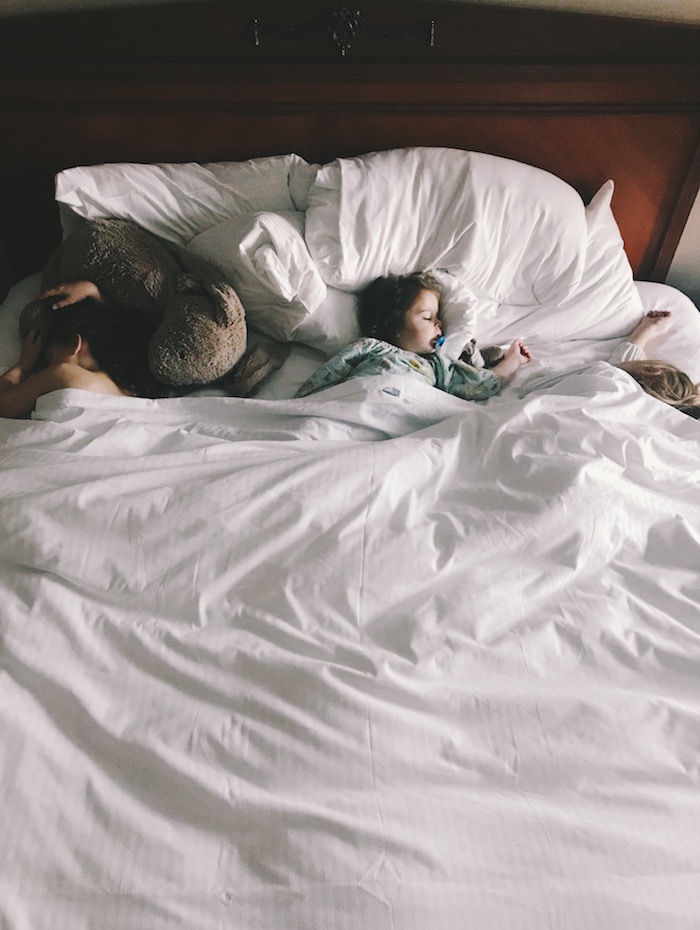
So the three days slowly filled up with favorite things: riding the trains in all the colors: orange, red, and green, ice skating downtown, holiday movies in the hotel room, dinner with old friends, scootering under the light-wrapped branches of the naked trees down Commonwealth Avenue, sharing a sloppy tiny dark hot chocolate at Burdicks, joyfully singing “Dreidel dreidel dreidel, I made it out of clay…” as a giant Menorah lit in the square outside our windows, and yes, even the overpriced gingerbread house tradition.
In which, incidentally, we had the loveliest time building together and trading candy supplies and I couldn’t believe we were at a stage where I could sit quietly with my three daughters for two hours while they carefully applied bright candies to frosting smears and plied each other with their extras.
And for myself, the treat of those moments of wandering on one’s own–for morning breakfast sandwiches from Flour, a breakfast date with a friend at Juliet, a late evening drink with friends at the Bristol lounge–that feel more accessible when one is just up the street.
(The Nutcracker ballet performance stayed off the list, not because of price as you can often get steeply discounted tickets, but because we’ve gone the last few years and last year I sensed that it had ceased to feel as special as one would imagine a child’s attendance at a ballet performance might feel.)
After we left, I realized there was a second important reason for our visit, besides seeing friends and revisiting a few favorite traditions at a time when the city is at its prettiest. The things we did and the places we stopped still meant something to us. We still have mental maps of where things are and how to get there and we felt vague ownership over our experiences had there. But the longer or more frequently we are away, the more those will fade. One cannot hold two existences in hand at the same time. An adult can believe that they will, but really one is being colored with nostalgia while the new one is formed. And for a child, the old one fades to almost black-and-white levels of the distant past. I caught Alma staring at the passerbys and shop windows like she’d never seen a wide avenue before in her life. Is this how quickly it goes? I wondered.
-
glamp more; White Mountains, New Hampshire
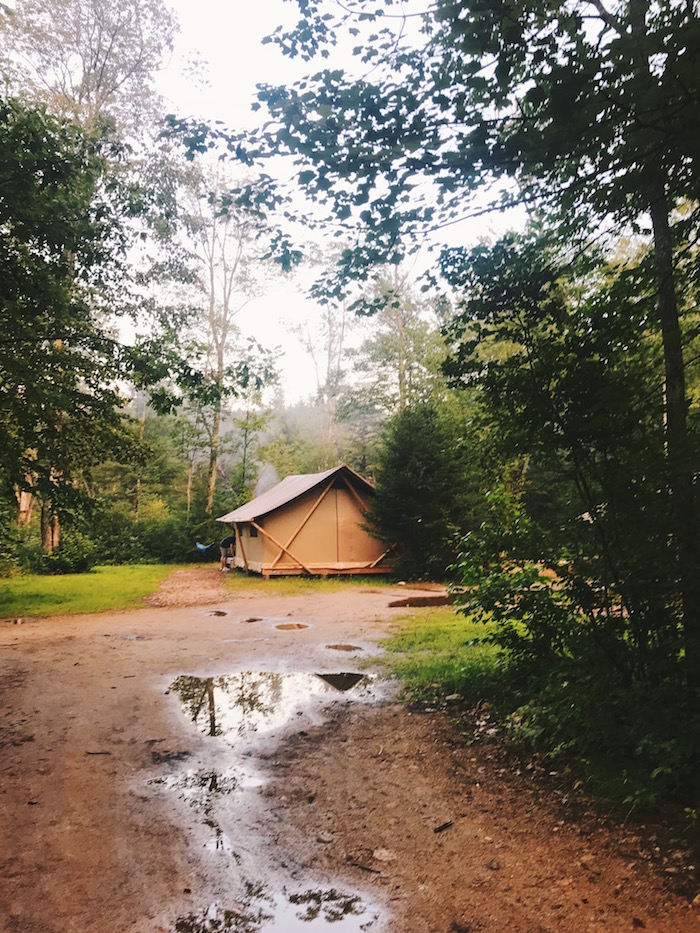
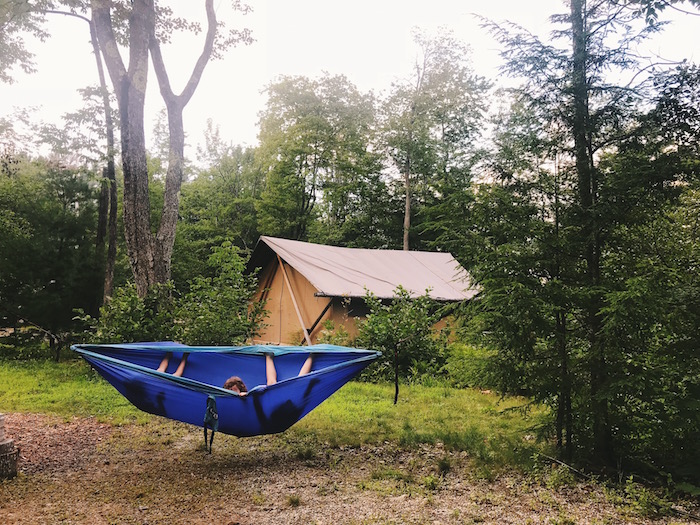

A few notes on our wonderful time as guests of Huttopia–they offered us a tent for free and we paid for a second one for Joe’s parents who came with us. There is so much elegance to this crisp camp set on a former Boy Scout campground. That may be because the company is a French one, and they have their method down pat. So much so that there were many European and Canadian visitors at the camp with us during our time. In talking to one fellow camper, I learned that Huttopia has something of an enormous following in Europe and is effectively a lifestyle brand there. So it’s pretty fun to encounter their first USA location in New Hampshire.
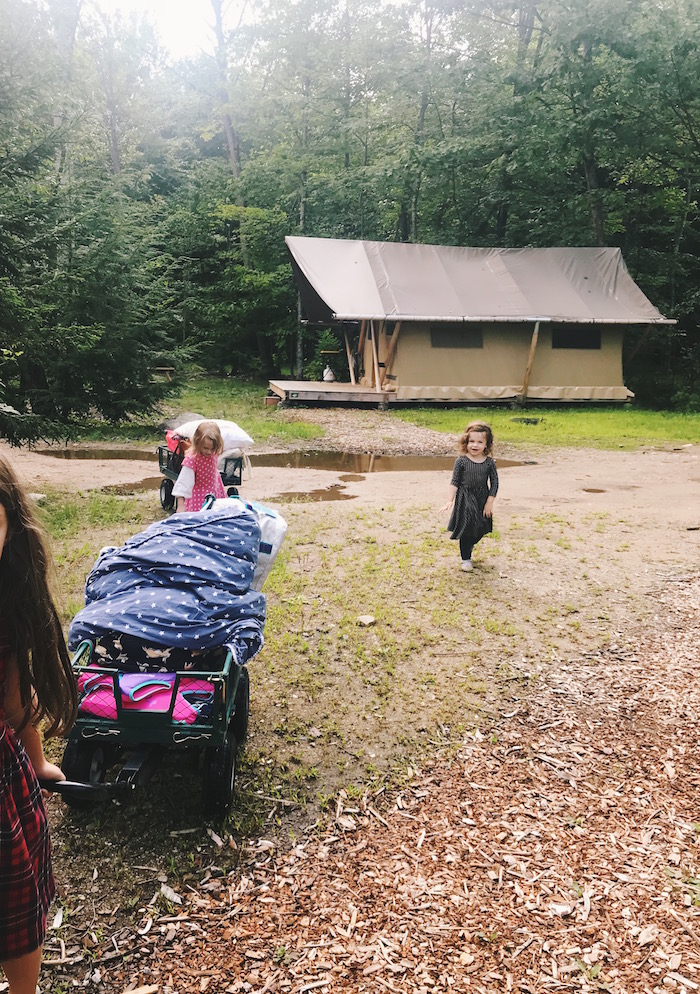
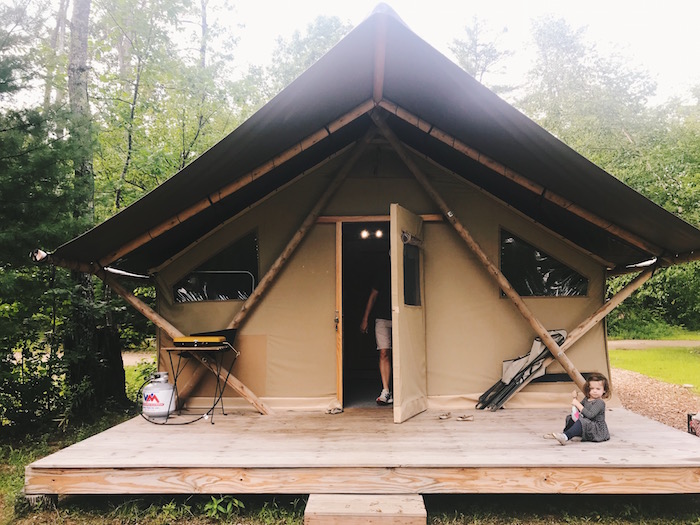
Sleek tents, tidy campsites, a pretty and warm swimming pool, a generously stocked camp store, and fun daily activities for kids. I didn’t grow up camping, but my best friend did, and I always enviously listened to her stories of cavorting around the campground nearly parent-free for the week. At Huttopia, I totally got a sense of that freedom for the girls. Because there were no cars allowed at the campground beyond the parking lot, they felt free to roam the roads. They liked walking to the playground on their own, and getting sent on errands to the camp store. And they LOVED the evening showing of Moana on the baseball field that got a sprinkle of rain, the better to cuddle under their blankets for. If we had planned the trip with a couple family friends they would have had a blast just running to each other’s campsites and checking in.
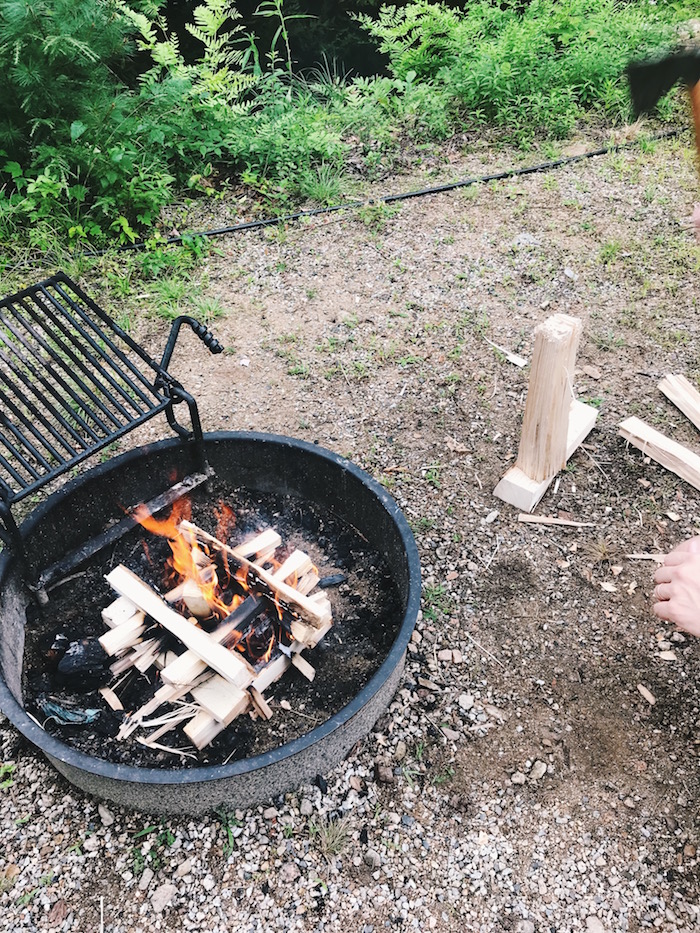
Joe keeps a hatchet in the back of our car (such soccer moms!) for all our fire needs, so he can make spiffy designs like this on the go. The Huttopia camp store sells firewood, but unfortunately the firewood for sale when we were there was not aged enough and did not burn well. We recommend picking some up on your drive, nearby grocery stores stock older wood.
That flip-grill thing is on all the fire pits and is genius. Love it. Practically eliminates the need for cookware over the fire.
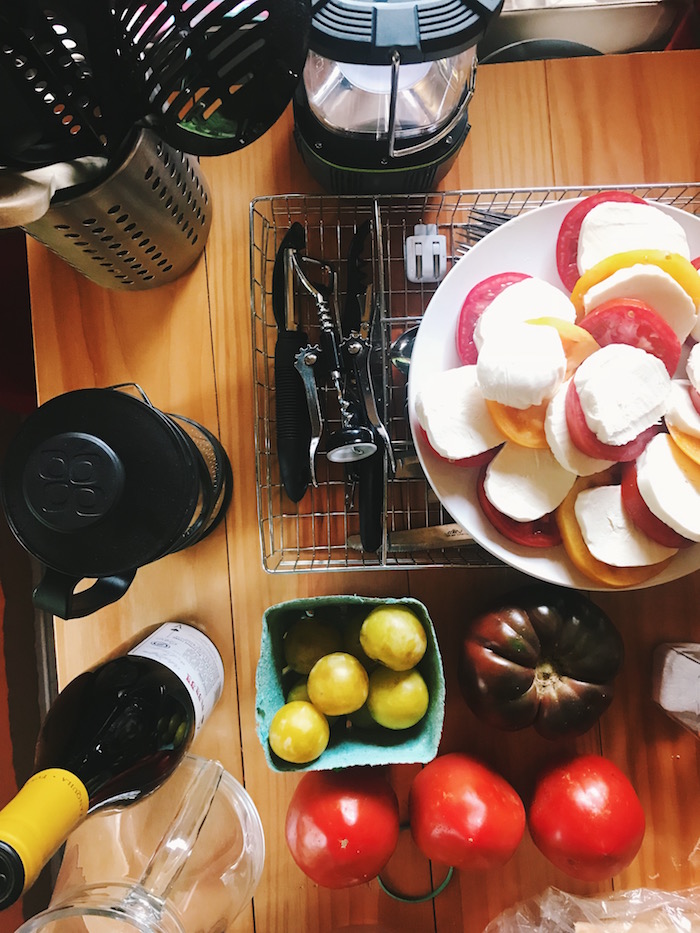
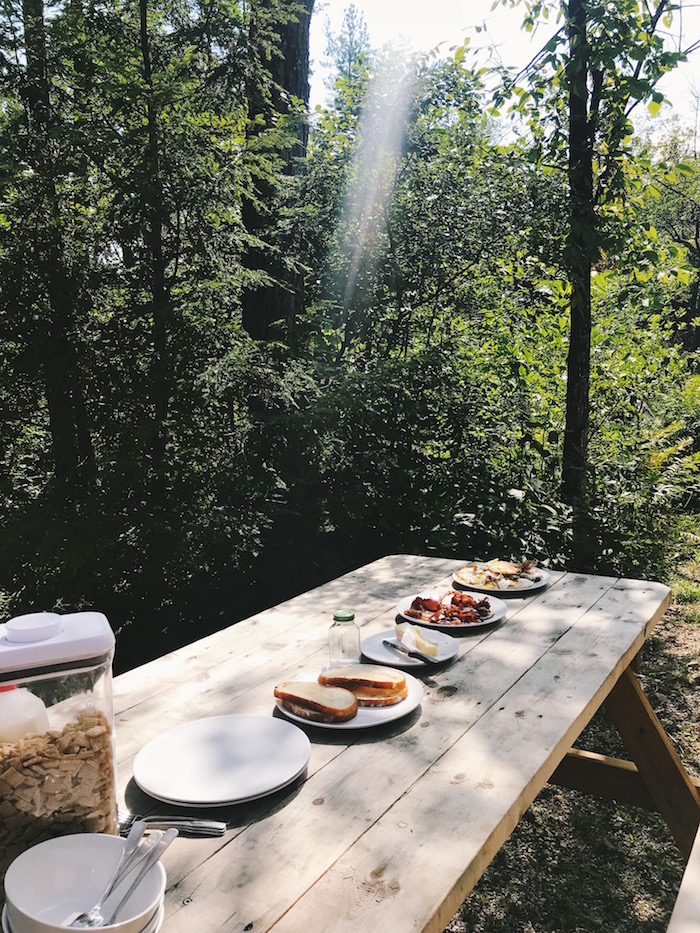
Diana’s Baths nearby is an easy (and extremely popular) adventure. The trail to it is practically stroller friendly. For two year olds it takes one adult with them at all times as the rocks are slippery, but for ages five and above, there’s lots of independent play to be had.


A few items I might suggest you bring along:
-your own pillow, always a nice luxury
-coffee ground for a French press (the press is provided)
-a tea kettle–just easier to deal with than a pan
-fan, in case of hot & humid temps
-bug spray for the evenings after dark-cozy food supplies, like bacon, hot coco mix, wine, and these all natural cheetos rip-offs that I find to be insanely good.
-fire wood, see note on this above
-it always pays to bring your own hammock, we have this brand and bring it everywhere!
Some of you told me you were going after I posted on instagram that we were there, how was your trip?
-
Ticks: rumors and murmurs

Sipping green tea and thinking how very interesting it is to be a mother of young ones in today’s America. Naturally from here, I could lead this conversation just about anywhere, but today’s circuit of fascination: Lyme’s disease.
If you grew up around ticks, the idea of checking your children for ticks is quite standard, if not a traditional summer activity. But whether you grew up around them or not, the fact is that today’s parents are facing an outdoors full of ticks with epic levels of Lyme infection.
Lyme is one of those things I’ve started bringing up around other moms, casual-suggestively, to learn if I’m missing something. At a book club, sitting around a long table in a lush backyard, I eagerly leaned in as the woman across from me cataloged all the steps she’d gone through after finding three ticks on her daughter. -But what about sending it to one of the websites? I asked. -Practitioners don’t think those are reliable. False positives. False negatives. -But you can’t prescribe doxy…I murmured. -Our pediatrician is prescribing doxycycline.
This was news to me. I’d been told no pediatricians were prescribing doxycycline to children. Amoxicillin only, though it had no recorded success with Lyme. Her doctor’s office was less than a mile away from mine. And yet, different approaches were happening between the two places. to children. in ways that would affect them for the rest of their lives.
Of course there’s a reason this is on my mind. I found an engorged tick on one of my children that had been on her for three days. Not having peeked behind her ear for those three days was a one weekend slip-up, with the potential of the worst consequences. I pulled it off perfectly, sent it to tickcheck.com perfectly (although, if you are in this situation, I highly recommend paying extra for it to get there as fast as possible), consulted my pediatrician and waited anxiously perfectly…and received my text message that said the tick did not have one of nine diseases it could have had. It did have one, but it was not one that is considered dangerous in our area (borrelia mayonii). My city pediatrician was surprised I had found this website and sent the tick off quickly. The only reason I had done so was because a friend from Martha’s Vineyard told me too, because where she vacationed this was considered standard procedure. Even though just a few weeks later I was told that these private-enterprise-tick dissection labs are not considered reliable, I am still really glad I sent it. If I still had seen a rash on my child, I would have asked for a Doxy prescription. But those results, paired with no rash, no fatigue, muscle aches, and no fever, gave me confidence to set this worry aside.
“On the West Coast, when it comes to natural disasters, they have earthquakes. The heartland has tornadoes. The South has hurricanes. Here in the Northeast, our natural disaster is Lyme disease,” said Kevin Esvelt, who specializes in a field called evolutionary and ecological engineering at MIT Media Lab.” –CNN
(except, not quite so regional as that, since Lyme infected ticks are rapidly spreading in the Midwest as well.)
For those who study Lyme disease and see patients with Lyme, signs seem to indicate that there is no pinning this malicious insidious disease down. Maybe you’ll get a rash. Maybe you’ll have a fever. Maybe you’ll see the tick. Maybe you won’t. Maybe it will test positive or negative at tickcheck.com or something similar. Doxycycline is the only known working antibiotic for Lyme. Doxycycline is not recommended to be prescribed to children as it is known to affect bone growth and stains their teeth. However, it is being prescribed because practitioners are now feeling that it is better than having the Lyme go untreated.
And a separate branch of this discussion begins right there: the long untreated cases of Lyme that were ignored or misdiagnosed for years. This branch of the conversation is centering around a lonely and grim theory: Is Lyme disease a Feminist issue? Take One, and take Two.
Researchers and insurers have often insisted not only on positive test results but also on the classic signs of early Lyme infection, such as the distinctive bull’s-eye rash and swollen knee joints, even though many people infected with the spirochete bacterium do not present such signs. Some of the symptoms of “chronic Lyme”—headaches, exhaustion, and cognitive dysfunction—have been dismissed as too vague or too similar to those of other conditions to be accorded diagnostic weight. -The New Yorker (see One above)
It feels overwhelmingly like the general knowledge database is broken here. It feels like it is totally on us to know everything we can.
This is when a light blue filter slides into my mind and I begin to see filmy images of the future, Minority Report style….what if playing in the woods soon looks like children scampering around in permethrin lightweight suits? What if we never get a vaccine and instead genetically alter mice, deer, embryos, whatever we can to introduce inoculation? What if the equivalent of giant weekly bug bombs becomes standard treatment for anything out-of-doors? What if tick immune robot cats are the new housecats?
Then I switch back to my admittedly healthy and yellow filter life in happy Massachusetts. I believe children can still play outside. I don’t believe we have to resort to toxic chemicals on our lawns. I believe it’s still safe to have indoor-outdoor pets. I believe we can catch this disease in the act of infection, and we can treat it. But, I believe we should be talking about it.
In this spirit, I want to mention a few homegrown prevention approaches I’ve encountered recently:
- Cistus Tea: made from leaves grown in Eastern Europe, rumored to successfully make human and animal drinkers repellent to ticks.
- Elevation: No rumors here. There are fewer ticks at elevations over 1000 ft.
- Dr. Bronner’s Peppermint Soap: landscapers claim that washing in Dr. Bronner’s peppermint soap makes them unappealing to ticks as they hike through the bushes, trimming back overgrowth in yards up and down the east coast. A refreshing soap and a bug repellent? I’ll take it.
- Animals: guinea hens (but dang, are they loud!), chickens and possums are all rumored to eat up local tick from your grounds. Whether maintaining these animals as ground control is worth it, is up to you!
- Cedar oil: a known effective natural deterrent for household pets, safe around children and pregnant women.
- Nightly tick checks for the entire household. Tried and true through the generations.
- Insert your tip here! What have you learned?
To close, a link to this excellent recent summary of the options with bug spray, including the general sense that DEET is not so bad after all.
Obvious disclaimers….I am not a doctor, scientist, or professional researcher. This content is not intended to be a substitute for professional medical advice, diagnosis, or treatment. The advice & statements on this blog have not been evaluated by the Food & Drug Administration. Any information on this blog is not intended to diagnose, treat, cure, or prevent any disease.
-
a volunteer opportunity

A good friend of mine is building a network of volunteers to help the people hurt and displaced by ICE and border control and the government. They are looking for volunteers in big cities, in coastal cities, but also widely dispersed cities. They are looking for people with lots of days to help, and people with just one day to help. Spanish speaking would be an enormous plus, but isn’t it always? Not required. They are working with all the organizations you’ve heard about (and probably donated to!), as helpful “what can we do?” on-the-ground-action folks. And: it’s working.
For examples of some of the things getting done, small things that quickly add up to enormous things, check out their Twitter feed Together&Free.
To volunteer click here.
It feels like it takes a lot of cherries to make a pie but in the end it takes only about fifty, and then you’ve got a pie of great beauty instead of fifty separate cherries wondering where to begin.
-
30 days


We have an exciting 30 days ahead of us. My parents, siblings, in-laws, and niece are headed to Greece to travel on a boat together and bicycle for eight days. Before we meet up with them, Joe and I have planned a far too brief four day trip to Rome with the girls.
My parents planned many family trips when I was a kid/young teen. Two extended motorhome trips with six kids, a Switzerland bike and train trip (with all seven kids and a buddy friend for my disenchanted teen brother), annual winter week-long vacations that centered exclusively around the beach and the pool with zero tourism goals unless you count leaving for the closest fish shack every night.
My dad’s company had reward trips that my parents often advocated to take us on as well. Months in advance, the company would send a guidebook to whatever location had been chosen. I would grab it off my mom’s desk and read through the whole thing–an early sign of my deeply held love of researching beforehand!
As a mom, I know now that travel is testing, expensive, and exhausting, yet manages to change your perspective on everything.
And all of my siblings travel what seems like constantly. The three in California go on stunning weekend road trips in that way that is so easy in California. Another two are “based” in Africa which really means they fly internationally almost every month, and the one in New York City has the flexibility to head off on festive jaunts throughout the year.
I’m really looking forward to this trip with them which has all the activity and adventure built in, but will allow for tons of together time as well.
Anyway, all this planning made me want to post these photos of magical Northern California from back in March!
I went with my mom, my mom’s sister Anne, my brother who lives in Los Angeles, my brother who lives in San Francisco and my sister Joanie. Joe watched the girls at home for three days. It flew by in a whirl of wine tasting, delicious food and absolutely stunning scenery.

The roads were edged with plants that I only see in greenhouses here, enormous versions of something I typically see in miniature. It felt like every square mile—even people’s front yards—were planted with vineyards.
Along the road I noticed a little sign that said Our Moon Still Shines.



Even from Boston (especially if you follow the wonderful (Hither & Thither), one can easily establish that Scribe Winery has an amazing following and is a beautiful place to visit. Joanie knew that they had recently renovated an antique Hacienda on the property and now reserve it for seated tastings with food. The food is served family style in generous bowls, and the tables are far enough apart to allow for easy conversation.
The gardens, house and property glowed with winter desert color: silt, sand, clay, cobbles.


My sister planned the trip, riffing on trips she’d previously taken for ideas, though it sounded very difficult to decide where to go! So many beautiful places. She hired Peter as a driver for the six of us. Of course a driver is very wise to have when tasting wine, but it also makes for an entirely different experience. It was such a luxury to climb back in the car and stare out the window as we went place to place. As a mom I rarely get that tuned-out gazing-out backseat experience that childhood was full of. He was also able to riff on what we wanted, if we needed takeout, a grocery stop, or wanted to grab coffee, he could incorporate it easily on the fly for us.

After Scribe we drove back through the small town of Sonoma and stopped at the lovely wine tasting room of Kamen. We only had about a half an hour, so we split several tastings among ourselves. They were lovely to chat with and the wines were delicious.
Then we headed to Hamel Family Wines, where the tour began with a walk through their gorgeous fields. They have a stunning build-out, clearly one for future generations to enjoy.



On the way home we called ahead and picked up Mexican from El Molino Central. Delicious seasonal tacos and mole with homemade tortillas, served out of a cheerful cafe on the side of the road in Sonoma. We brought our dinner back at the rental home, sharing a bottle we’d bought that day. The time change was finally catching up with me and I went to bed early!
The next morning, first up was Ashes & Diamonds. On a flat stretch of Napa, just off the main road highway 29, they’ve a styled tasting room and a fleet of wines to match. With their sumptuous green velvet, brilliant yellow paint, and an abundance of the Saarinen chairs, it felt like Hollywood flew in for a styling.

Perhaps my favorite trip photo: this yellow, this brother. ^^
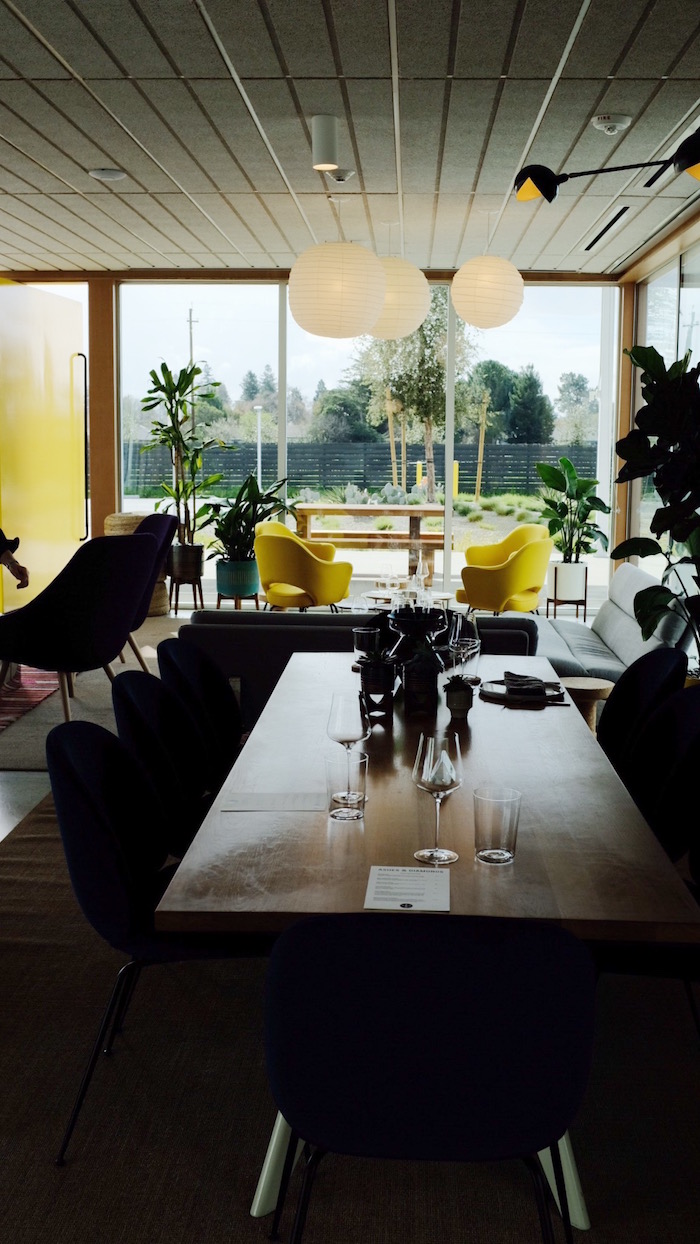


At Ashes & Diamonds, we discussed how the land restrictions to qualify as a winery have changed over the years—from 100 acres, to 60, and now to only 10–which I found fascinating. I really enjoyed seeing this place and imagining the possibilities of a younger generation deciding to invest here.


There were many things that seemed repeat thematically no matter where we tasted, so much so that when I left they were still playing in my mind…
For one thing, everyone was using the Coravin method of opening bottles. It looked intense and gadget-y in the otherwise tranquil wine tasting space. It has thin medical grade needle that goes through the cork, allows you to remove a tiny amount of wine, and replaces the space in the bottle with argon gas. I had never seen it before in my life. But the pourers said it could preserve an open bottle of wine for up to a month. I love to have a glass of wine while cooking but am often reluctant to open a new bottle knowing I won’t be finishing it. However, the price tag is $250.
Second, everyone was using Heath ceramics. These ceramic dishes seemed to have their own thermal mass that made the food look delicious, no matter what it was.
Third, biodynamic. I was intrigued to hear many vineyards dropping this as a term as something they pursued. Biodynamic is a theory developed by the same person who came up with the Waldorf method of eduction: Rudolf Steiner. Isn’t that fascinating? Like many of his theories, it’s more of an overarching approach with a few oddly specific things—must have a goat, must let the clipped vines rot alongside the plants, let wild plants grow up among the vines. Funny to think how quirky yet persuasive ideas have staying power.
I brought home bread from the amazing Costeaux bakery, local butter, grape sized dates from the farmer’s market and of course, wine.
-
mother’s day gift guide

an annual review with detailed notes about all the progress that’s been made
frozen lemonade concentrate for the freezer because she can’t seem to find it at the normal grocery store anymore
gratitude cardigan
everyone’s nails trimmed
ticks eradicated from earth
wisdom earrings that whisper lucid answers to science questions
the assurance she will never forget the way their arms feel around her neck
a Taj Mahal of patience
Gandalf sense of where things are going
-
breakfast out
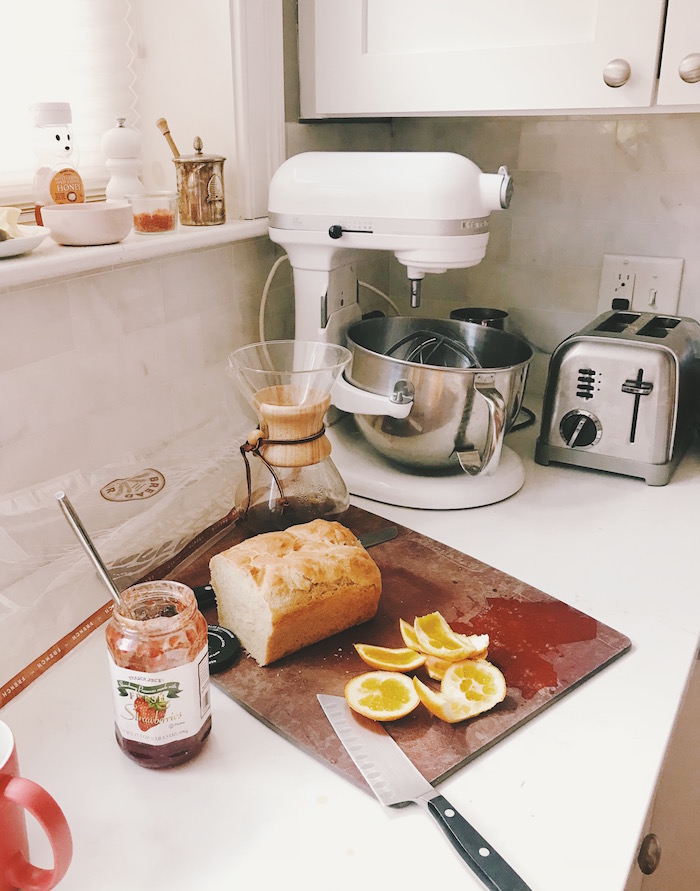
I’ve started getting one of the two older girls out for one-on-one breakfasts every other week. I whisper her awake and we sneak out in the morning before anyone else wakes up. Quietly close the door and head down the sidewalk to a chocolate chip pancake pillage (Lux), a modest plate of bacon (Joan).
The tenor is totally different and I can sense the girls soaking up the luxury of it. I can push Joan in the stroller if she doesn’t want to walk. I can let Lux set the pace on her scooter. We fit at a small table. They can order silly sugary drinks like chocolate milk. Our meals are quiet with spontaneous conversation that peters out and redirects easily.
She was soo good, the heady brunch crowd swilling mimosa pitchers cooed to Joan as we left. Joan looked baffled. It was a date, what was there to do but sit and talk?
My mom was really good about getting us kids out on one-on-one dining adventures, typically framed by errands. She adhered to a strict one child per week schedule. I could track the approach of my week four or five weeks out depending on how many siblings were in the circuit that year. I remember ordering an orange cream cooler, dominating the conversation and saying everything I wanted to say all at one time (my older brother remembers this as well).
In the summertime, there was a northern lake town with a bed and breakfast she would sneak us out to in the early morning. The woman who ran the place never printed a menu, instead she recited it as it was very simply whatever her husband wanted to make that morning. It was special for those one or two of us, and the others didn’t even notice we were missed. Perhaps they didn’t even realize we left at all, until it was their turn to be whispered awake.
-
“Yes but even 4 business men can’t poison God’s sunlight.” –ee cummings

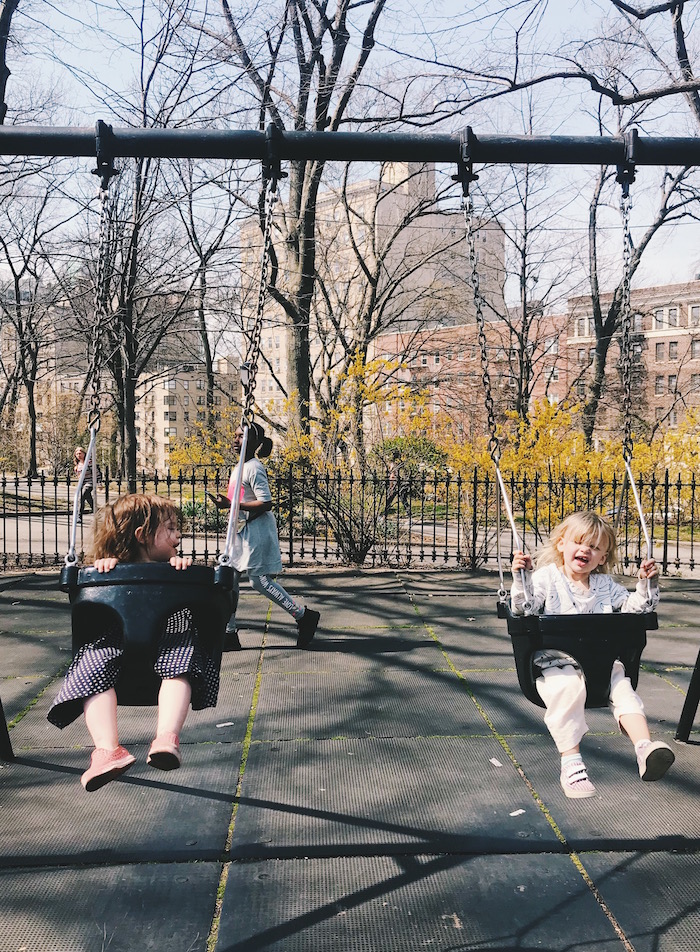
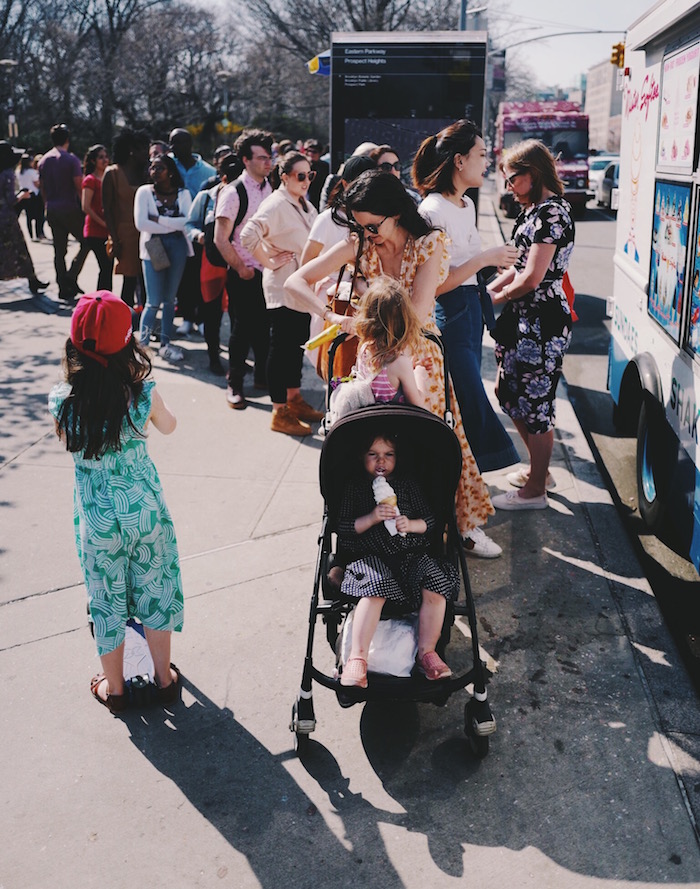
This weekend I put the girls in the car after a full day of school and after-school mild weather frolicking (ice cream, winter grass). We were driving to Brooklyn, I had preloaded all of their ipads for the five hour drive, and packed a lot of hardboiled eggs and dried seaweed snacks. Joe had a weekend in New Hampshire planned and I was up for the adventure.
My recent favorite ipad discovery is that Youtube allows you to download any video for off-wifi viewing. Lux adores all of the TedEd videos so hers was full of those. I like to put a medley of Joan’s interests at age 4.5 on hers, so she had:
- Joseph’s Machines
- Giant Pandas 101
- My Mom is an Airplane
- Jonathan’s Blue World episodes
- A dog and woman dancing at a dog show
- Grace Lehane playing to the cattle in Kilmichael Cork
Alma has an ipad as well. At age 2, it is a close to useless as it gets, mostly frustrating her and making her grouchier than she would be if she were just looking out the window. I give her the oldest one we have anyway because I do nearly everything 3×3.
We went to see my brother and his girlfriend who live in Williamsburg and another brother of mine who is soon moving to Crown Heights with his family. We stayed together in an old brownstone that was gorgeously antique, if a bit oddly laid out. Because we stayed together, we could still enjoy vacation things like letting the girls sleep in while my sister-in-law and I talked quietly in the kitchen, or putting them to bed and sharing a bottle of wine in the middle room late into the evening. While in town the girls and I finished reading these kid-friendly biographies on two amazing women that I had brought along: Elizabeth Blackwell and Rachel Carson.
Walking around Prospect Heights and Crown Heights I was a little in awe. It was the first sunny day in a long time (I saw someone on Instagram call it the great thawing of Brooklyn) and there was liveliness everywhere. The sidewalks were so wide, the coffeeshops were so cute, the bagels were so chewy. There were artists painting murals around construction sites and the playgrounds were full of happy kids sharing swings. There was giant line outside the Brooklyn Botanic Garden (always nice to see an epic brunch line outside of a garden).
Despite all the things you already know about New York from the movies, the cliches, the postcards, it still strikes you, and you’re tempted to murmur to yourself the greatest city in the world. At the same time, I’m still stunned that my brother has made his life there for the past seven years, and that now another of my siblings will live there.
Traveling with the girls alongside my brother who doesn’t have children and my other brother who has a well mannered two year old, I was reminded of how kid-centric I allow our days to be in Boston. The girls were slightly affronted when the entire itinerary wasn’t about what they wanted, and downright shocked when I was clearly more interested in adult conversation than their insights about the sidewalk. Although it works well for us at home in general, I would like to be more candid with them about how many things in which they are simply along for the ride. My and their understanding of how this should look is certainly a work in progress.
On our way home on Sunday it was blustery and cold again, but we stopped for a house salad and pizza at Grace Farms anyway. It is such a beautiful and unique spot, I love to see it in all weather conditions.
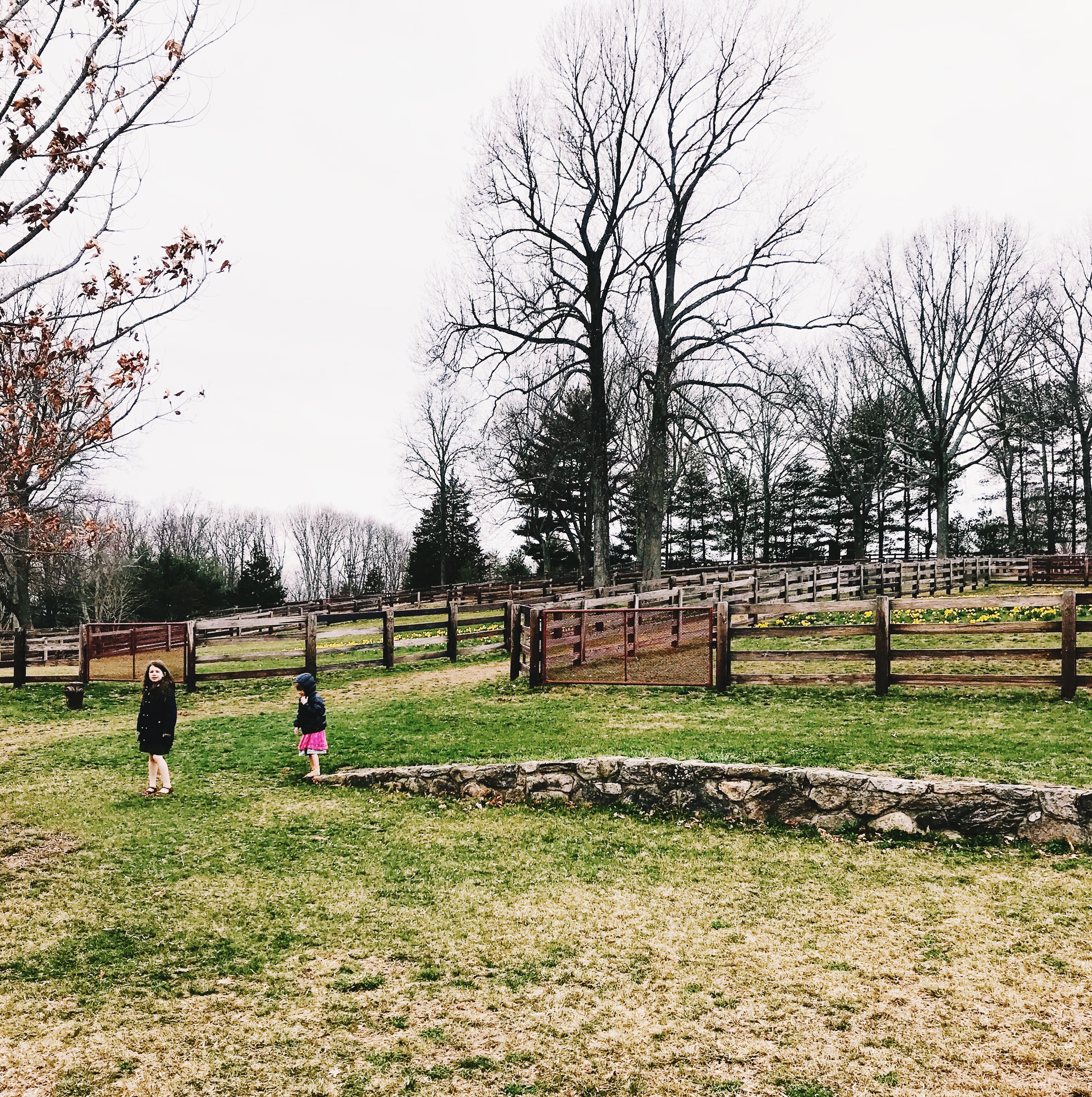
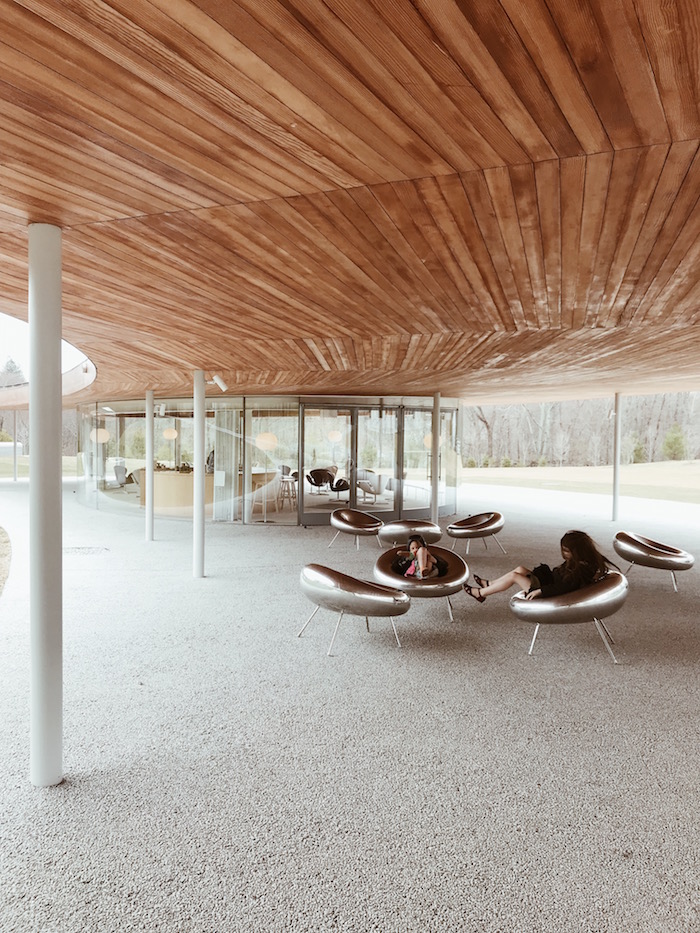
-
April at the Isabella Stewart Gardner Museum

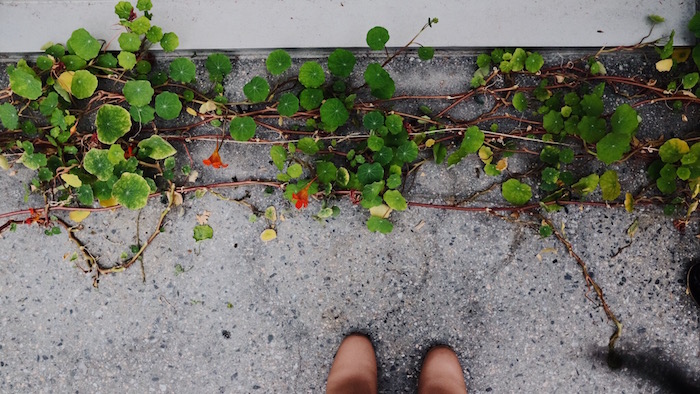
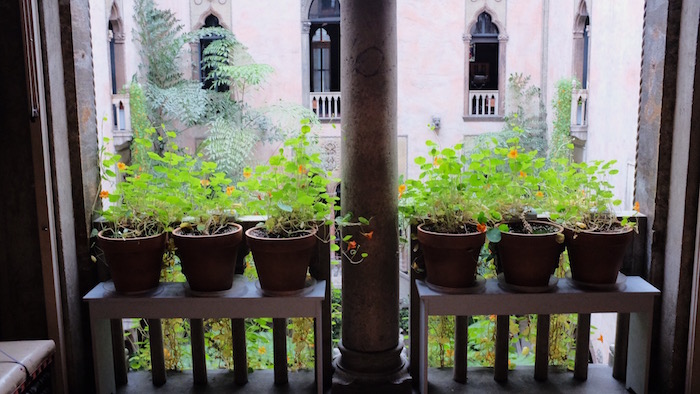




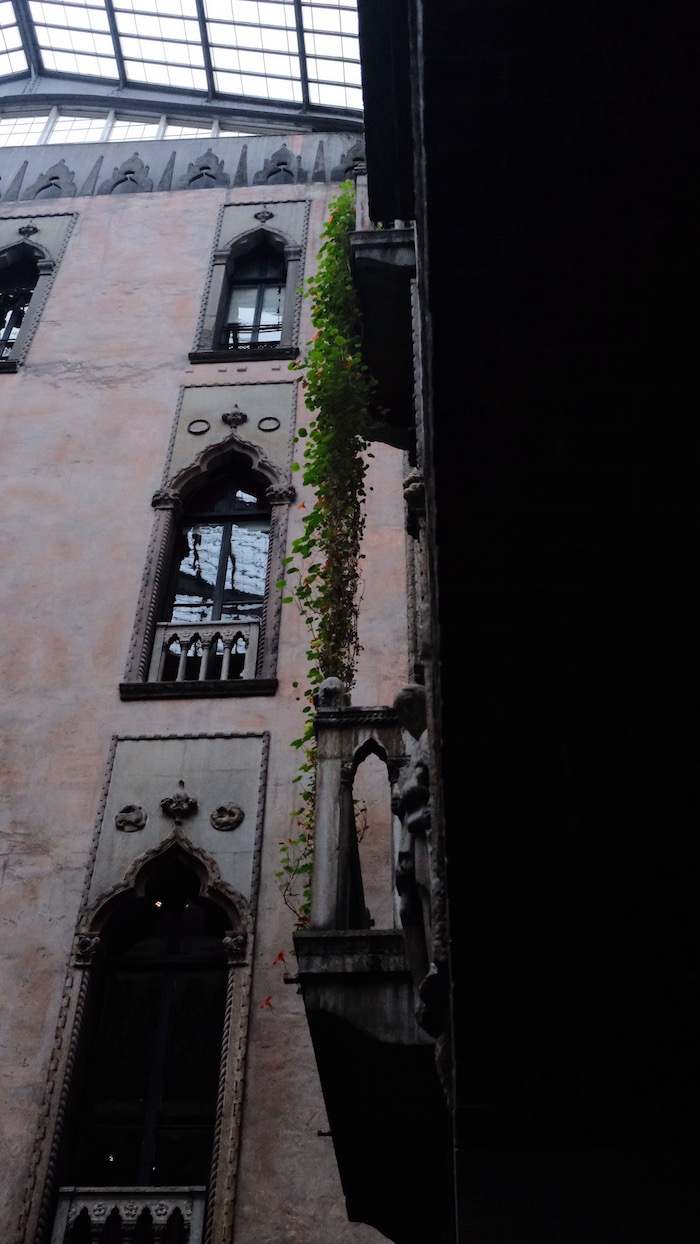

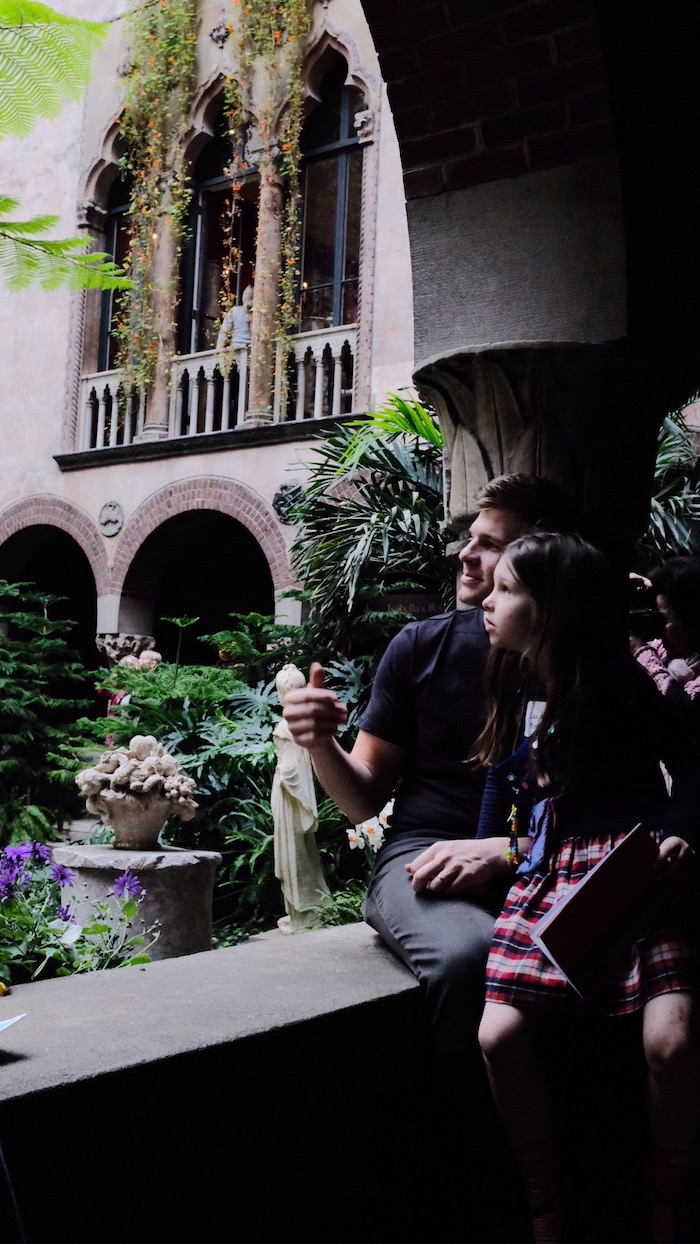
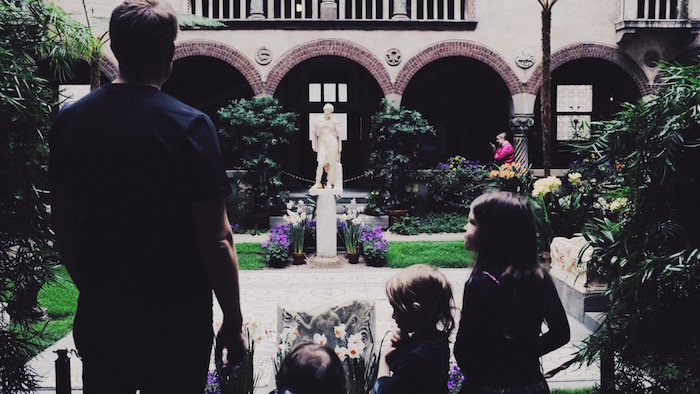
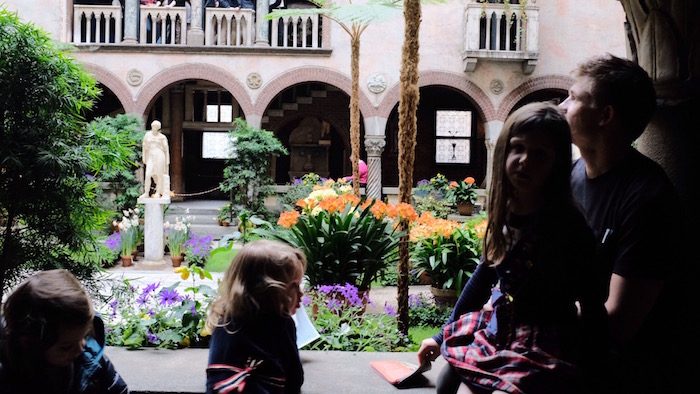
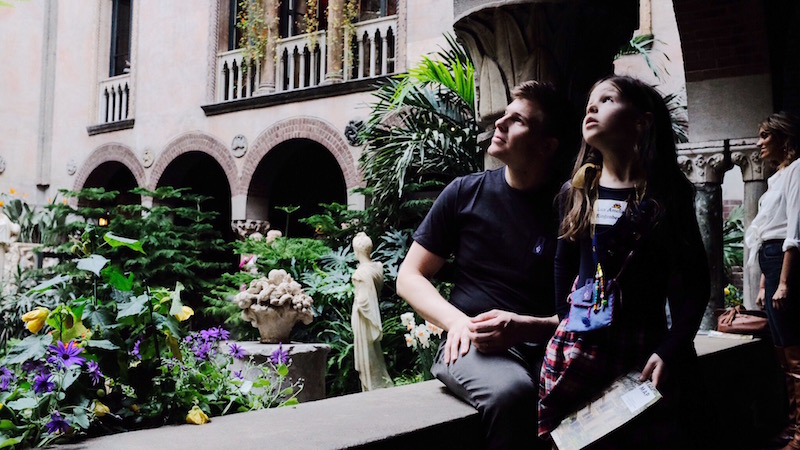
A museum with a century-old tradition of cascading twenty-foot long trails of edible flowers to celebrate spring (and April birthdays) beckoned us out this morning. There were some claims from the children that “another museum would be no good” and was a terrible idea, but I believe even they were wooed in the end. The fact that the palazzo style building is labeled Palace in all the museum’s posted signage got their attention as well.
We stumbled into some sort of national college-kid-visit-a-museum day which resulted in crowds, and cookies in the greenhouse, delightful.
There are lots of old treasures in the Isabella Stewart Gardner Museum but shambling around the central courtyard to see the flowers from all directions was the treat for us today. The nasturtiums were eagerly reaching toward the sky, their petite circular leaves like lily pads, and the courtyard was filled with flowers of all sorts to match their cheer. The horticultural staff begins growing the flowers nine months earlier, and manage to cajole them into thinking it’s summer, for Boston’s great benefit.
The casual, lived-in way that art is displayed at the ISG make it one of the more un-child friendly museums in Boston–because museum staff clearly worry a lot about their relics getting touched, and make that known to parents frequently. Having once owned a few nice things myself, back in the day, I relate to their reaction.
Therefore, it’s not at the top of my list of places to for families to visit in Boston, but in the month of April, I think it is! And keep in mind if you are local, you can likely get a discounted pass through your library. The restaurant is delicious, be sure to put your name in as soon as you arrive.